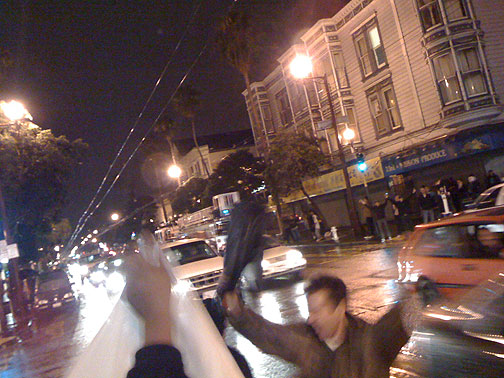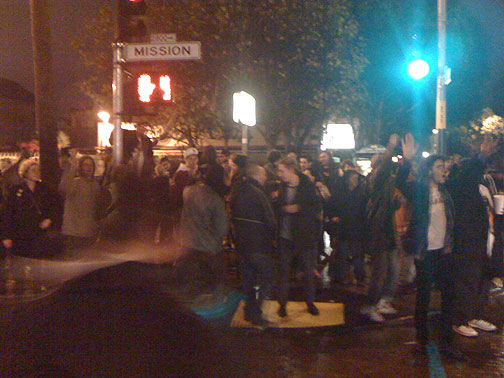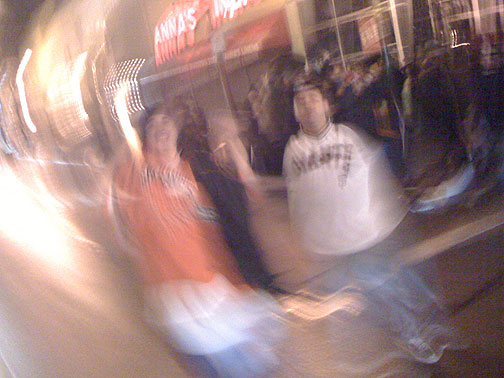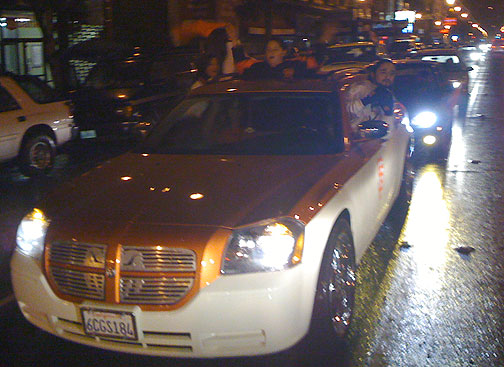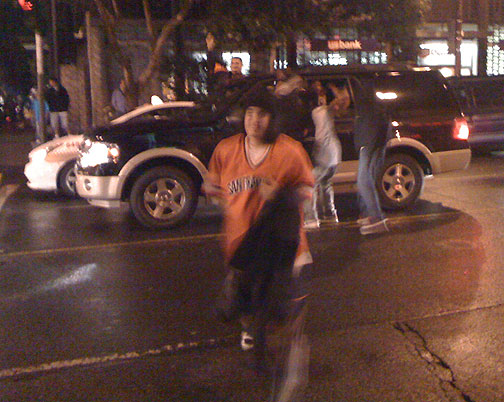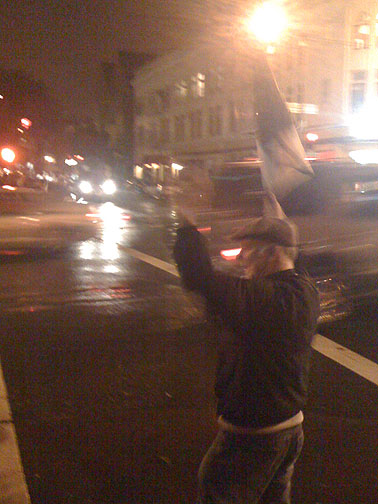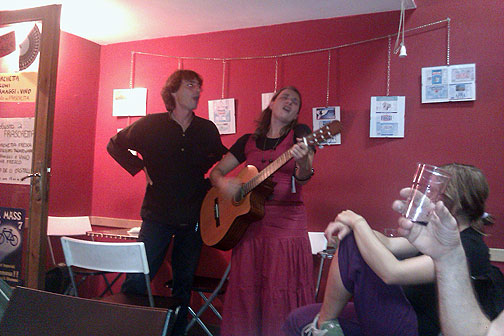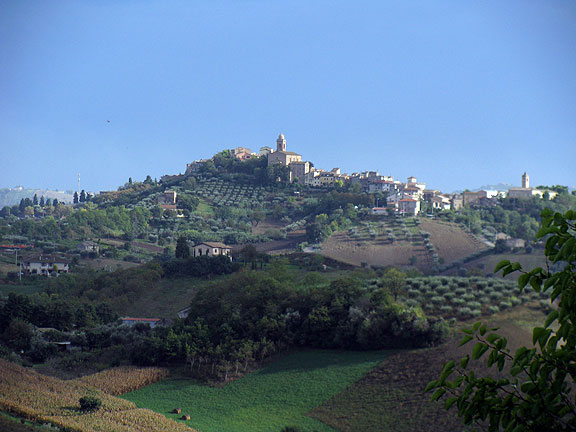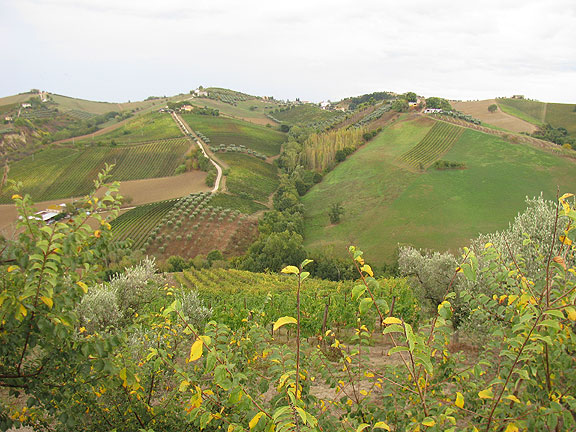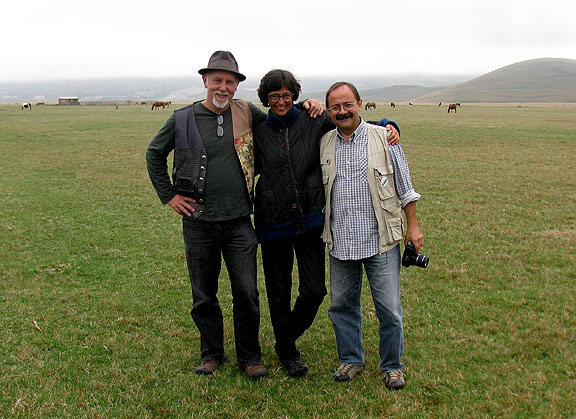Catharsis and ecstasy coursed through the streets of San Francisco after the climactic ending of the Giants-Phillies playoff game Saturday night. We headed out to 24th Street and immediately found ourselves surrounded by jubilant fans, mostly dressed in Giants hats and jerseys, all screaming with joy, waving and yelling and jumping around. Cars streamed by with delirious fans leaning out, waving flags, honking horns, even while the rain fell steadily on all of us. Walking towards Mission Street we high-fived dozens of friendly fans, strangers all, as we shared the excitement of the moment. An obese African American man, probably a few sheets to the wind, staggered by us shaking his head while talking to himself: “The Giants! The Fuckin’ Giants Won!…” Kids ran excitedly back and forth, hollering in triumph.
At the corner of 24th and Mission, the erstwhile Plaza Sandino was claimed by partisans of the Gigantes! Down Mission to 23rd and 22nd, more and more people filled the sidewalks, slapping hands, hugging, yelling and cheering. Fans jammed into SUVs and old Chevrolets cruised by, re-creating for a few hours the long lost days when low-riders would cruise back and forth on Mission for hours on Friday and Saturday nights. At the old “Live at Leeds” corner of 22nd and Mission, a cohort of frenzied teens clad in the inevitable baggy pants along with some random Giants gear, would pulse into the street with each light change, vigorously slapping hands with fans hanging from their cars. The SFPD in serious crowd-control mode began to appear in squad cars and along the sidewalks, but the tense balance of power between the celebrating fans and the uniformed soldiers of law and order was not breached, at least while we were out there for about 90 minutes.
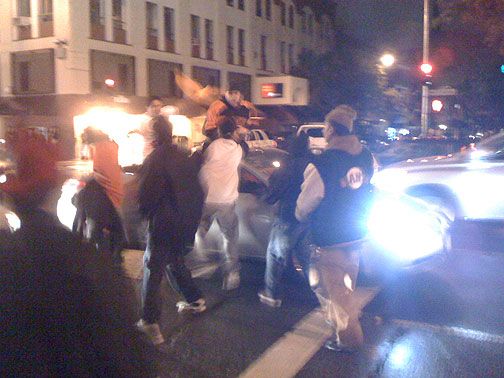
22nd and Mission: Giants fan standing in his sunroof greets teens who dance through intersection at every light change.
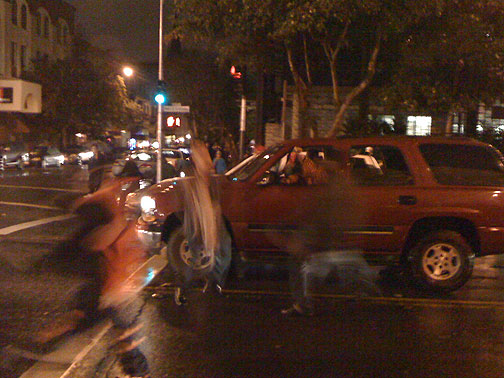
At 22nd Street and Mission the kids ran so fast in and out of the intersection that they turned ghostlike in this shot.
Sports victories bring people together in a way that few other events in our times do (I wrote about this back in 1984 in “We’re #1!” in Processed World #12, pp. 46-53). We can lament the apathy and obliviousness that generally accompany the political and social crises of our era. But the atomized, fragmented lives we mostly lead in our everyday existence are transcended by the sudden unity we experience in rooting for a local team who miraculously overcomes all odds to win the championship. The streets of the city are immediately transformed too. Warm greetings and camaraderie replace indifference, suspicion, and hostility. We share the streets of OUR city, and we are for a brief time a WE. It’s short-lived to be sure. How could it be otherwise? A bunch of millionaire athletes who shift from team to team with each passing season is hardly a “home team,” except for their briefly shared uniform and temporary “residence” at our local ballyard.
I know a lot of people could care less about baseball, or sports in general. But the Giants winning the National League championship in Philadelphia was a true classic, an incredible game of high suspense with a delightful ending wherein the good guys won! After an excruciating 3+ hours of the most unlikely twists and turns, Giants fans finally got their long-awaited reward when the Bearded One, closer par excellence Brian Wilson struck out Philly slugger Ryan Howard on a vicious slider that caught the bottom of the strike zone.
As we wandered further down Mission Street we found ourselves strolling behind a couple of guys, both wearing Giants hats, jackets and jerseys, bedecked in pins, indicating their long-time status as die-hard fans. We shared a few comments with them, noticing that they were puffing on triumphant cigars as they kept up the steady but luxurious pace of winners. Turns out they were season ticket holders and were going to walk all the way to the ballpark to join the celebration, but here they were on Mission, both born in SF, enjoying their neighborhood and the City in full-throated pleasure. They identified themselves as “Le Cat and Le Pieu” and we eventually said goodbye to them at 16th, but not before one of them started talking to me about the 56 years it’s been since “we” last won a World Series. The reference was to the New York Giants who last won it in 1954, four years before the franchise was moved to San Francisco to play in long-forgotten Seals Stadium at 16th and Bryant. He reminisced about the fateful line drive hit by the rookie Willie McCovey with two outs and the bases loaded in the bottom of the 9th, Game 7, of the 1962 World Series against the Yankees when the Giants were down a run. It was snagged by Bobby Richardson at shortstop, abruptly ending that dramatic World Series in despair for Giants fans. He also spoke eloquently of the painful collapse of the Giants in the 2002 World Series in Game 6, where they had a 5-1 lead in the 7th inning, seemingly coasting to the clinching win of that fall classic, only to have the bullpen give it up, and then lose Game 7 too to the despised Anaheim Angels.
It reminded me of the odd relationship we have to history. Most Americans can tell you a bit about WWII, maybe something about the Civil War, but that’s as far as most people’s sense of history goes. They might say something about “the Sixties” but it’s usually dismissive and trivializing. But ask any sports fan about their baseball team, or about who was a great pitcher years ago, or who was the greatest hitter of all time, and they’ll most likely have a lengthy explanation of their preference, fully backed up with dozens of factoids and statistical details, quoted from memory. The sheer quantity of historical memory associated with baseball can be staggering. Here I was walking down Mission Street, exchanging high-fives and hoots and hollers with other pedestrians as well as the dozens of passing cars, when I suddenly found myself in an earnest conversation about the history of the Giants, a history that the speaker clearly identified with as his own!
We walked up 16th to Valencia, wondering if the excitement was pulsing on that busy corner too, but found it strangely dead. Seems the hipster capital of San Francisco wasn’t too identified with the big win. No one was out celebrating, and the usual “too cool for school” crowd was busy with their drinking and eating. We wandered up to 17th and realized that the “action” was all back where we started, in the heart of the “real” Mission at the 24th street BART plaza. Sure enough, when we got back about 15 minutes later the energy was still crackling, and even more cars were rolling up and down the street honking and celebrating. One particular cream-colored sedan with a big orange Giants SF logo on its side managed to look as much like a Giants jersey as a car could!
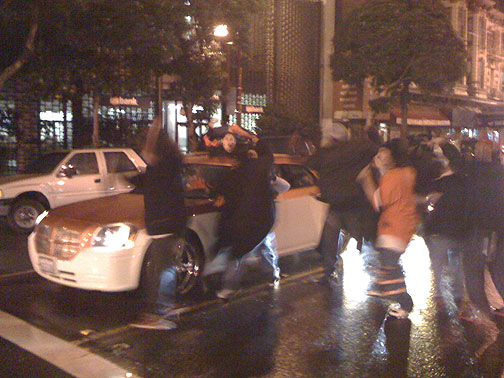
The kids went crazy over this cream-colored car with orange trim, a Giants SF logo made it look like a rolling jersey!
Unlike many baseball games, the Giants-Phillies finale had the rhythm of a great soccer match. From the beginning the Giants pitcher, Jonathan Sanchez, was out of control, both mentally and in terms of his ability to throw strikes. One might make the analogy with a sloppy goaltender in soccer, who gives up two quick goals before the game has even passed the 10-minute mark. So it was with Sanchez, who somehow managed to yield only two runs in the first chaotic inning, a frame that had all the earmarks of a full-blown collapse by the Giants. Watching at home on TV, the old familiar failure that has characterized local teams during the past decade was raising its unmistakeable head. Somehow though, the Phillies made three outs.
The Giants didn’t look particularly baffled by Philly starter Roy Oswalt, but they failed to score in the first two innings, losing a great chance in the 2nd after having hit into yet another of their endless double-plays. Forgotten in the craziness that was about to take place, Sanchez had a relatively easy 1-2-3 2nd inning before the Giants came up in the 3rd. Sanchez himself started it off with a single, and by the time it was over, two runs had scored and one had been thrown out at home in an exciting but somewhat frustrating inning. At least the score was now tied!
In the bottom of the third, Sanchez went off the rails entirely. He walked the first guy and then drilled Chase Utley in the back with an errant pitch. Runners on 1st and 2nd and nobody out. He didn’t like Utley flipping him the ball that was lying near the first-base line, and apparently called him a schoolyard name. Utley, fully macho in his own right, returned the gesture and even took two small steps towards Sanchez. Instantly, the benches emptied and the hilarious ritual mislabeled the “baseball brawl” took place as 40-some players milled about in the infield with a few of them jawing at each other, maybe one or two actually grabbing at each other in anger. Meanwhile, in the Giants bullpen Jeremy Affeldt continued his warm-ups and after the brouhaha was settled, Giants manager Bruce Bochy yanked Sanchez and turned to his bullpen for a 7-inning effort. Affeldt came through by retiring three of the most feared Phillies hitters, preventing either runner from scoring, and shutting them down again in the 4th inning too.
The game took on a surreal quality as each side kept mounting threats, putting one or two guys on base, but never able to bring them home. Here the soccer rhythm came fully into play. Just as in a soccer game, each team rushes down to the other’s end and gets off a dramatic shot or two, but no one can score. The tension builds and builds. By the end of the 7th inning there had been so many scoring chances for both sides, but still the score was 2-2 (when it was all over each side had left 11 men on base). In the top of the 8th, Juan Uribe came up with two outs and nobody on. On the first pitch he belted it just over the right field fence for a home run and a 3-2 Giants lead! Delirium for Giants fans! The incredible catharsis of a goal finally scored after so much waiting and disappointment”¦
In the bottom of the inning, the Phillies had to face Giants ace Tim Lincecum, who was brought in as a relief pitcher in an unusual move by the manager, and he got the big first out, retiring slugger Jason Werth who had tormented the Giants all series. But the next two hitters got singles and with two on and one out Bochy brought in Brian Wilson, the best closer in the National League this season. But not infallible! Under the circumstances, it was a high-stress moment. I climbed up on the back of my couch, literally climbing my wall in anxious anticipation. After a couple of pitches to Phillies catcher Carlos Ruiz (a guy who has been a clutch contributor in the past two post-seasons), he hits a screaming line drive. Everyone in San Francisco gasped, but before we could let the agony sink in, the ball disappeared into first baseman Aubrey Huff’s glove who then calmly flipped it to shortstop Edgar Renteria at 2nd to double off the runner, end of inning!! The Baseball Gods were definitely on the Giants side, and if that double play line drive didn’t prove it, what would?
The Giants failed to score in the 9th, and now it was all on Brian Wilson to finish the victory. He did his usual job, pure torture! (Giants announcers Duane Kuiper and Mike Krukow dubbed Giants baseball “torture” around August, as the wins started coming but always after excruciatingly tense endings.) Two on and two out and the best hitter, Ryan Howard, at bat. The count went full, 3-2, as it had for the previous batters”¦ a foul ball, and then, incredibly, Howard stands looking as a perfect slider curves over the plate at the bottom of the strike zone. Strike 3! He’s out! Game over! Giants win the pennant! Giants win the pennant!
Everyone into the streets!
Now the World Series looms. San Francisco vs. Texas! Talk about your symbolic match-ups. My pal Rebecca Solnit has just written about the David and Goliath struggle of citizens vs. corporations through the prism of California’s Proposition 23, wherein Texas oil companies (with the help of the Koch Brothers and other right-wing financiers) are attempting to reverse the measly climate change legislation we have in California to enhance their profits and ongoing destruction of the environment. The initiative is called the California Jobs Initiative or some such funhouse mirror of a title, but so far it’s losing in the polls”¦ Let’s hope the voters of California defeat the Texas oilmen just like the Giants will defeat the Texas Rangers in the World Series!
Vamos Gigantes!
Thanks to Adriana Camarena for all the great photos!

